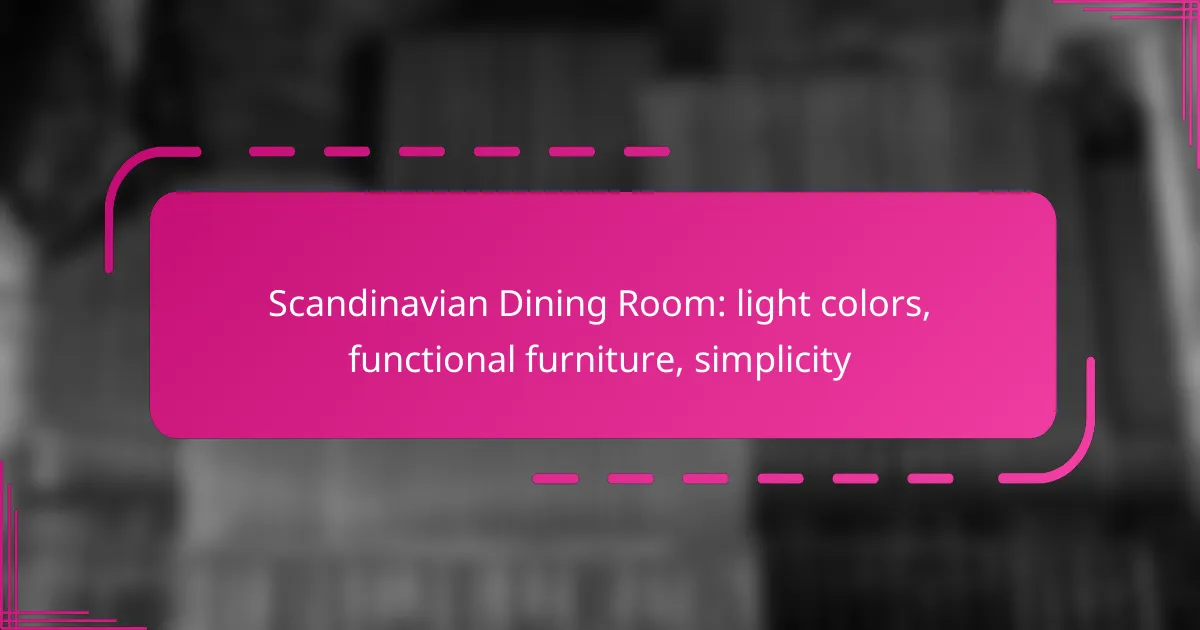Scandinavian dining rooms embody a harmonious blend of light colors, functional furniture, and simplicity, creating serene and inviting spaces. The emphasis on minimalism and practicality ensures that each piece not only enhances usability but also contributes to a warm and stylish atmosphere. By incorporating natural materials and clean lines, these designs foster a sense of comfort and elegance in any home.

How to Choose Scandinavian Dining Room Furniture?
Choosing Scandinavian dining room furniture involves selecting pieces that emphasize functionality, simplicity, and light colors. Focus on designs that enhance usability while creating a serene and inviting atmosphere.
Focus on functional designs
Functional designs are central to Scandinavian style, prioritizing practicality without sacrificing aesthetics. Look for tables and chairs that are comfortable and easy to move, allowing for flexible dining arrangements.
Consider multi-purpose furniture, such as extendable dining tables or storage benches, which can adapt to different needs and occasions. This approach maximizes utility while maintaining a clean and uncluttered look.
Prioritize light color palettes
Light color palettes are essential in Scandinavian dining rooms, creating an airy and spacious feel. Whites, soft grays, and muted pastels are popular choices that reflect natural light and enhance the overall ambiance.
When selecting furniture, opt for pieces that feature these lighter tones or incorporate light wood finishes. This not only aligns with the Scandinavian aesthetic but also makes the space feel more open and inviting.
Consider space-saving options
Space-saving options are crucial, especially in smaller dining areas. Look for furniture that can be easily stored or tucked away when not in use, such as stackable chairs or foldable tables.
Incorporating benches instead of traditional chairs can also save space while providing additional seating. This flexibility allows for a more dynamic dining experience without overcrowding the room.
Evaluate material durability
Durability is a key consideration when choosing Scandinavian dining room furniture. Opt for high-quality materials like solid wood, which not only offers longevity but also aligns with the natural aesthetic of the style.
Additionally, consider finishes that are easy to clean and maintain, such as lacquered surfaces or treated fabrics. This ensures that your furniture remains functional and visually appealing over time.
Incorporate natural elements
Incorporating natural elements is vital in achieving the Scandinavian look. Use materials like wood, stone, and textiles that bring warmth and texture to the dining space.
Adding plants or natural decor items can enhance the connection to nature, which is a hallmark of Scandinavian design. This not only beautifies the room but also promotes a sense of calm and well-being.

What are the key characteristics of Scandinavian Dining Rooms?
Scandinavian dining rooms are defined by their light colors, functional furniture, and simplicity. These spaces prioritize minimalism and practicality, creating an inviting atmosphere that emphasizes comfort and style.
Minimalist aesthetics
Minimalist aesthetics in Scandinavian dining rooms focus on clean lines and uncluttered spaces. Furniture is often sleek and functional, avoiding excessive ornamentation. Neutral color palettes, such as whites, grays, and soft pastels, contribute to a serene environment.
To achieve a minimalist look, select a few key pieces of furniture, such as a simple dining table and streamlined chairs. Avoid overcrowding the space with unnecessary decor; instead, choose a few statement items that enhance the overall design.
Emphasis on natural light
Natural light plays a crucial role in Scandinavian dining rooms, enhancing the airy and open feel of the space. Large windows are common, allowing sunlight to flood in and brighten the room. Light-colored walls and furnishings reflect this light, further amplifying the effect.
To maximize natural light, consider using sheer curtains or no window treatments at all. Mirrors can also be strategically placed to reflect light and create the illusion of a larger space.
Use of organic materials
Organic materials are a hallmark of Scandinavian design, promoting a connection to nature. Wood, particularly light-toned varieties like birch or pine, is frequently used for furniture and flooring, adding warmth and texture to the dining area.
Incorporate natural elements by choosing wooden dining tables and chairs, or by adding decorative items made from stone or ceramics. Look for sustainably sourced materials to align with the eco-conscious values often associated with Scandinavian design.

What are popular Scandinavian Dining Room styles?
Popular Scandinavian dining room styles emphasize light colors, functional furniture, and simplicity, creating a serene and inviting atmosphere. These styles often incorporate natural materials and minimalistic designs, making them both aesthetically pleasing and practical.
Mid-century modern
Mid-century modern Scandinavian dining rooms feature clean lines, organic shapes, and a blend of functionality and elegance. Furniture pieces often include iconic designs from the 1950s and 1960s, such as tapered legs and simple forms.
To achieve this look, consider using a mix of wood finishes, such as light oak or walnut, paired with neutral color palettes. Key elements include a statement dining table, comfortable chairs, and decorative lighting that enhances the overall ambiance.
Contemporary Scandinavian
Contemporary Scandinavian dining rooms focus on current trends while maintaining the core principles of simplicity and functionality. This style often incorporates innovative materials and designs that reflect modern living.
When designing a contemporary space, opt for sleek furniture with minimal ornamentation and a cohesive color scheme. Incorporating elements like geometric patterns or bold accents can add interest while still adhering to the Scandinavian ethos.
Rustic Nordic
Rustic Nordic dining rooms embrace a cozy, warm atmosphere with an emphasis on natural materials and textures. This style often features reclaimed wood, stone accents, and earthy color palettes that evoke a sense of comfort and connection to nature.
To create a rustic feel, choose furniture that highlights craftsmanship, such as handcrafted tables and chairs. Layering textiles, like wool throws or linen tablecloths, can enhance the inviting nature of the space while adding warmth and character.

How to incorporate light colors in Scandinavian Dining Rooms?
In Scandinavian dining rooms, incorporating light colors creates an airy and inviting atmosphere. Focus on using whites and soft pastels to enhance the sense of space and simplicity typical of this design style.
Use white and pastel shades
White is a foundational color in Scandinavian design, providing a clean backdrop that reflects light. Pastel shades like soft blues, greens, and pinks can be used for accent walls or decor to add a subtle touch of color without overwhelming the space.
When selecting paint or furnishings, consider using matte finishes for a more natural look. This approach helps maintain the simplicity and elegance characteristic of Scandinavian interiors.
Mix with wooden accents
Integrating wooden accents can add warmth and texture to a light-colored dining room. Choose light woods such as birch or pine, which complement the soft hues and enhance the overall aesthetic.
Furniture pieces like dining tables or chairs in natural wood tones can create a harmonious balance with the light colors. Aim for a mix of finishes to add depth while keeping the space feeling cohesive.
Layer with textiles
Textiles play a crucial role in adding comfort and visual interest to a Scandinavian dining room. Use light-colored table linens, cushions, and curtains to soften the look and introduce additional layers.
Consider materials like cotton or linen for their breathable qualities and natural feel. Mixing textures, such as a knitted throw or a woven rug, can enhance the cozy atmosphere while maintaining a light and airy vibe.

What are the best brands for Scandinavian Dining Room furniture?
The best brands for Scandinavian dining room furniture emphasize light colors, functional designs, and simplicity. Notable brands include IKEA, Muuto, and Fjords, each offering unique styles and price points to suit various preferences and budgets.
IKEA for affordability
IKEA is renowned for its affordable Scandinavian dining room furniture, making it accessible to a wide audience. Their products often feature clean lines and light wood finishes, which embody the essence of Scandinavian design.
When shopping at IKEA, consider their modular options that allow for customization and flexibility in small spaces. Look for items like extendable dining tables and stackable chairs, which maximize functionality without compromising style.
Muuto for modern designs
Muuto stands out for its modern interpretations of Scandinavian design, offering furniture that combines aesthetics with practicality. Their dining room pieces often feature innovative materials and bold colors while maintaining a minimalist approach.
For a contemporary dining room, explore Muuto’s range of dining tables and chairs that emphasize both form and function. Their designs often incorporate ergonomic features, ensuring comfort during meals and gatherings.
Fjords for quality craftsmanship
Fjords is known for its high-quality craftsmanship, focusing on durable materials and traditional techniques. Their dining room furniture often showcases natural wood and luxurious upholstery, reflecting a commitment to sustainability and longevity.
When selecting Fjords products, consider their ergonomic dining chairs that provide excellent support, making them ideal for long dinners. Their attention to detail and comfort ensures that each piece is not only beautiful but also functional for everyday use.

How to create a functional dining space?
To create a functional dining space, focus on light colors, practical furniture, and simplicity. These elements work together to enhance the room’s usability while maintaining a clean aesthetic typical of Scandinavian design.
Choosing Light Colors
Light colors are essential in Scandinavian dining rooms as they create an airy and spacious feel. Shades like white, soft gray, and pale pastels reflect natural light, making the area feel larger and more inviting.
When selecting a color palette, consider using a combination of these light hues for walls, furniture, and decor. This approach not only enhances brightness but also allows for easy coordination with various design elements.
Functional Furniture Selection
Opt for functional furniture that prioritizes practicality without sacrificing style. Look for pieces that offer storage solutions, such as tables with built-in drawers or benches that double as storage units.
Multi-functional furniture is ideal for smaller spaces, allowing you to maximize usability. For example, extendable dining tables can accommodate more guests when needed, while minimalist chairs can be easily stacked or stored away.
Simplicity in Design
Simplicity is a hallmark of Scandinavian design, emphasizing clean lines and uncluttered spaces. Choose furniture and decor that embody this principle, avoiding overly ornate designs that can overwhelm the space.
Incorporate a few key decorative elements, such as a simple centerpiece or a piece of artwork, to maintain interest without cluttering the dining area. This balance of simplicity and functionality will create a serene and inviting atmosphere.
